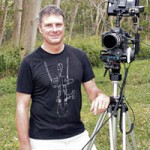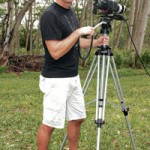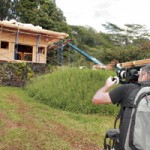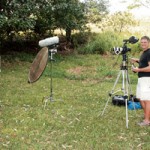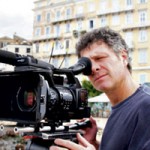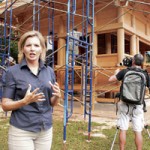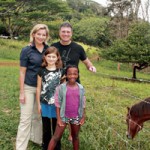Lens on Kauai
After shooting for some of the biggest networks on television, Serge Marcil is now focused on stories much closer to home on Kaua’i
Serge Marcil has crawled inside Mayan pyramids with archeologists, filmed cheetahs in Namibia and captured the traditional hunting methods of the Inuit of Iqaluit. So it makes sense that Kaua’i would be the kind of place to settle down and film – incessantly.
The Montreal-born film-maker, who has directed more than 40 episodes in TV series for National Geographic, Discovery and MTV, traveled the world a long time before landing on Kaua’i. But, he says, this is the only place that ever felt like “home.”
Now it’s time for Marcil to feature the Garden Isle nationally.
“We want to showcase the spirit of the people and the talent that is here,” he says.
Marcil owns the production company 4D Adventures with wife and executive producer Jennifer.
Having worked with show biz heavyweights such as Janet Jackson, Marcil is more impressed with scholars and anthropologists such as Wade Davis. Even more than that, he says, is how enamored he is with the abundance of cultural, historical and geographical inspiration found on Kaua’i and among its people. It’s perfect for a documentary series (or two or three).
Of course, he already has become well-known on the island for his smaller documentaries, including a short for the Ho’ouluwehi Center at Ka’apuni, the Kaua’i Music Festival and covering the building of the temple at Lawai International Center.
But there is just so much more to do.
“We were just blown away,” he says.
One thing has led him to another in his life, including being the only director allowed to follow and film the Dalai Lama for MTV Canada, or meeting people such as Spanish designer Paco Rabanne. “All of the projects I have worked on always had something amazing about them,” he says.
And the same goes for his projects on the island: One has led to another, and he hopes it continues that way.
That includes being introduced to Eric Knutzen, director of Ho’ouluwehi, the Sustainable Living Institute of Kaua’i, by Helen Cox, chancellor of Kaua’i Community College. Knutzen is partnering with Kaua’i County Housing Agency and other stake-holders on a sustainable living center project.
“Because of the scope of the project and its very nature, we (with Jennifer and Serge) immediately felt the desire to collaborate with Eric and showcase it,” Cox says. “Capturing the KCC sustainability projects cinematically enthralled many, and is just an introduction of what Serge is capable of producing on Kaua’i.”
The film was entered in the G.E. Focus Forward International Short Film Competition, a video contest based on the theme of innovation and technology.
Around the same time, the Marcils met local musician Mike Baez during the 2012 Kaua’i Music Festival and immediately thought of including him in the soundtrack for the Ho’oluwehi project.
“We also felt it was imperative to include something that was ‘zen’ in nature,” he says, “and the sound of Riley Lee’s shakuhachi (traditional bamboo flute from Japan) immediately came to our minds.”
So when Lee visited Kaua’i in August for the Lawai International Center’s “Pilgrimage for Compassion,” it was kismet.
“We got in touch with him and humbly asked if he would perform a song or two for our project,” recalls Marcil, “and he graciously accepted.”
The recording took place the following day at Raku Media studios in Kalaheo, with the help of musicians Thayne Taylor and Chris Burkett.
4D Adventures also made The Warm Heart, a one-hour TV special with artists from the Kaua’i Music Festival.
But perhaps what lights up Marcil’s face the most is the work he’s done filming the construction of a temple at Lawai International Center, which is being done without nails, based on the 13th century construction style, with materials brought in from artisans on Taiwan and Japan.
“That story is really fascinating,” he says. “The dream of the people who have been the story of the Lawai International Center … so beautiful.”
Marcil, Jennifer and their children frequent the center to enjoy its serenity, and Jennifer volunteers there, too.
“Jennifer likes to be in touch with orchids and all that they do,” Marcil says. He volunteers elsewhere, including Wilcox Elementary, where his daughters, Janique, 8, and Emmanuella, 10, attend school.
“We asked if we could come in and share,” Marcil says of participating in the Wilcox Kids TV Video Institute, where children act, direct and help create interviews and public service announcements for broadcast on Wilcox Kids TV. “We enjoy helping them out any way we can.”
It is only natural that Marcil enjoys introducing youths to his craft, as he got his start in the film industry at the age of 10, discovering a desire for acting early on.
“I was fascinated by television from a very early age, and I wanted to know how to tell stories like that – with images, sounds. So I entered every imaginable contest the two French television broadcasters of the time had for kids.”
Subsequently he was chosen to host a television series, L’imagination au Galop (“Galloping Imagination”), a children’s TV show that might compare to Electric Company in the U.S. “Those were the golden ages of TV,” he says. “You had a lot of budget, a lot of collaborations.”
He was then sent to Europe for a shooting that lasted four weeks and thus was introduced to television production.
“This is where I really fell in love with it,” he says. “From that point onward, I knew that directing was what I wanted to do.”
As a tween, he hosted another children’s television special during the 1976 Montreal Olympics, but knew he didn’t want to be in front of the camera long-term. He wanted to be behind the lens, putting his vision to fruition for viewers. The problem with acting for Marcil was its lack of creative freedom and what he describes as a sense of inauthenticity, something he noticed even at that young age.
“I never felt uncomfortable in front of the camera, but I felt like I was regurgitating facts as a host,” he says.
Marcil went on to create plenty of children’s educational series, including Mystery Hunters II on Discovery Kids in 2002 and 2005, and Popular Mechanics for Kids (TV series documentary) in 1997, which won an award for Best Direction in an Information Program or Series.
He plans to help document the journey of Hokule’a, too, on the accompanying escort boat that will conduct educational and scientific curriculum, another educational series that can benefit children.
As for what’s up next, Marcil is being open, but picky.
“It has to be connecting traditional wisdom and sense of community with the 21st century,” he says. “For us, basically the vibe is important, and we want to do quality, culturally relevant projects to root every project in Native Hawaiian wisdom and produce it with the latest technology.
“We want to focus on what unites us,” he adds. “That is the spirit behind the projects of 4D.”
Wife and co-executive producer Jennifer offers her perspective on what that means: “capturing positive values that contribute love.”
To view one of Marcil’s works, go to youtube.com/watch?v=RibFM9WKVg
- Having shot for National Geographic, Discover y and MTV channels, Serge Marcil is now focused on stories closer to home here on Kaua’i
- Serge Marcil
- Serge Marcil shooting at Lawai International Center
- Jennifer and Serge Marcil filming at Lawai International Center
- Serge Marcil shooting in Italy. Photo courtesy of Jennifer Marcil
- Jennifer explains the work being done while shooting at Lawai
- Jennifer, Emmanuella, Serge and Janique

